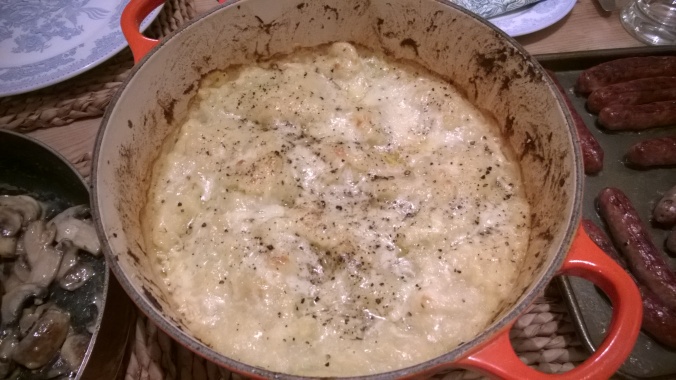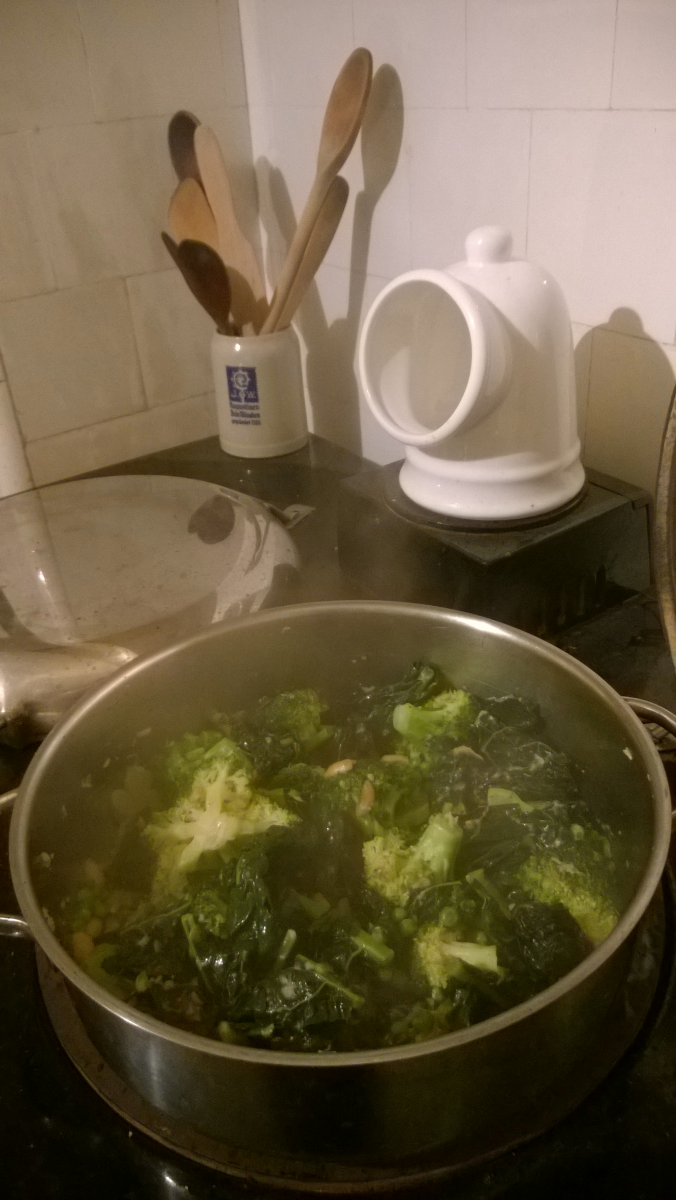
If ever a dish had the power to warm both heart and soul to the core; this is it!
Food can mean so much more than nutrition alone. When you cook up ‘something special’, which you mightn’t normally cook; your actions can relay a real sense of occasion. You’re conferring a special treat, and with it, you’re communicating a range of sentiments: comfort, warmth, love & nurture. Nothing says “I care” quite as much as dedicating your time to producing your level best! A poet does it with words; the cook does it with dinner!
But to achieve these wonderful results, it needn’t follow that the process itself prove complicated or difficult; nor that you’ll be slaving for hours, then end up with a huge mountain of washing up! This recipe is actually incredibly simple, but the finished dish is anything but… I strongly urge you to give this a go – you won’t be disappointed!
Enough of results; let’s focus on contents…! Do you see rice in the picture? Am I advocating carbohydrate on a low carb blog? Heaven forbid! What I’ve served this with is cauliflower rice; a true godsend on any low carb or paleo plan. I hyperlink the recipe to this as follows: cauliflower rice recipe.
And the beef itself? The brisket is slow cooked over hours, which means that excess liquid is staved off and the sauce requires no thickening-agent whatsoever. Indeed, all ingredients in this dish are suitable for both classes of diabetics, or anyone following a ketogenic / low-carb diet or paleo-regime. Beyond this, it’s suitable for all, so cook it for some ‘carb-eating friends’; they’ll never know!
So to begin, bring you beef-brisket to room temperature and season well.
Brisket is an ideal cut for slow cooking. Why? Cows don’t have collar-bones. This means that the entire weight of their head and neck is borne up by muscle. By necessity, that muscle must be pretty strong; so it contains high amounts of collagen, a structural protein which requires long slow cooking to break down and tenderise before it’s ready.
Pan fry brisket at your peril – you’ll end up with tough, fibrous strips which are truly unpalatable in every which way. But with slow-cooking, the collagen gelatinizes which naturally thickens the sauce (as per oxtail) and delivers delicious tender meat which simply melts under the fork – you’ll scarce need a knife!
Once the meat is room-temperature and the oven is good and hot; place the brisket into a heavy-based casserole pan, then straight into the oven for circa 20 minutes until the joint is sealed and deliciously brown on all sides.
Whilst this is looking after itself, quarter a couple of onions, then halve each segment into eighths. Peel a couple of cloves of garlic and roughly chop, followed by a green pepper, a leek, some celery and any odds & ends you may wish to use up. To be honest with you, as long as the onions and garlic are there, you can pretty much use any low-carb vegetable you wish. Try a dice of celeriac or courgettes – delicious!
Once the meat has browned, remove it from the oven and place the pan onto the hob. Tumble in your vegetables, followed by a couple of bay-leaves and a sprig or two of parsley if you have it. Return to the oven for 5 minutes, until the vegetables are good and hot, then bring out the pan once more and deglaze with a whoosh of red wine or port.
Why do I keep taking the pan back out of the oven, then in again, like a saucepan-hokey-cokey? Who wants to clean the hob unnecessarily…? Keep it clean as you go, then afterwards you’ll feel all the more smug as you get to relax all the sooner…
When the alcohol has reduced into a delicious cloud of steam, follow it by two cupful’s of water, a couple of beef stock-cubes and a generous teaspoon of Dijon mustard. You can of course use fresh beef-stock if you wish; if you do, then omit the stock-cubes and water. With regards volume, I state ‘two cups’, but depth is the real key here. You want the joint when on its side to be waist deep in liquid; no more, no less. Once achieved, allow the sauce to come to the simmer on the hob, then put the lid firmly onto the pan and into a slow oven it goes for circa 4-6 hours until it is achingly tender.
Why is the timescale so vague? A dish like this is pretty forgiving. As long as the oven is low enough and there’s sufficient water, it could easily go in overnight and not suffer – in actual fact, it’d be all the more delicious! What does a low oven mean? Think gas mark 1-2, circa 140-150°c. I have a cast-iron range cooker, so into the simmering oven it goes and I needn’t even peek until dinner time!
Once the time has elapsed, remove from the oven and take the lid off the pan. There should still be at least a cm of liquid and the most delicious, rich, savoury smell should serve as your reward! Check the sauce for seasoning and adjust if required. Place the lid back on the pan, then leave to one side to ‘rest’ whilst you cook the cauliflower rice.
Why do people always tell you to leave meat to rest? My own interpretation of this is somewhat grizzly and gruesome. If you’re of a nervous disposition, then please jump straight to the next paragraph, stopping reading from this point onwards…. Look down at your forearm, then tense your arm-muscles. Imagine cutting a knife through that; it would literally tear in the most rough and brutal way and you’d need a saw to get through it! With heat (like exercise), the muscles and tendons tighten, much like when you’re tensing your forearm. It would be a nightmare to cut through and would never achieve a clean slice. Now un-tense your arm. It’s clear to see how the muscles relax and lose their stress. Relaxed muscle (ergo meat) will cut cleanly, resulting in less moisture loss in the form of meat-juices, and a melting tender consistency. A good sharp kitchen knife will do the job – no need for a saw here (the same goes for a steak knife). As I say; that’s my own version of events – it’s always been the easiest way for me to envisage the process, serving to explain why meat should always be left to rest before carving. Take it or leave it… it works for me!
Gruesome bit over – the fragile amongst us can now resume. Cook your cauliflower rice as per the recipe under the hyperlink (cauliflower rice). Then simply lift the meat out of the pan and place atop the still al dente rice, spooning the beautifully reduced vegetables and sauce all around.
For that all important final professional flourish, garnish with chopped herbs: basil, parsley or oregano. Then simply carve the beef and dig in! The carving can almost be done with a wooden spoon.
Despite my long-winded, tiresome explanations, this recipe couldn’t be simpler. But I’m sure you’ll agree, it tastes anything but! So give this a go and toast the onset of winter with a bowl of pure comfort!
Thanks for reading and bon ap!
A.


 All things considered; this recipe is a winner on every level! I’m admittedly not good at oriental cuisine. My comfort zone is far more the long slow-cooked dishes of the classic European repertoire; which languish leisurely in the oven, whilst the cook enjoys the odd glass of wine or two…
All things considered; this recipe is a winner on every level! I’m admittedly not good at oriental cuisine. My comfort zone is far more the long slow-cooked dishes of the classic European repertoire; which languish leisurely in the oven, whilst the cook enjoys the odd glass of wine or two…

 I’m often heard to say that ‘fusion food’ only leads to confusion… for the palette anyway; but this in no ways means that East & West can’t sit comfortably together on the kitchen bench, sharing the warmth of the hearth…. Well in this recipe; they not only sit, but share a generous glass of good honest ‘Scotch’ together. Confusion only kicks in therefore if they down too much of the stuff! So be sure to mark the bottle.
I’m often heard to say that ‘fusion food’ only leads to confusion… for the palette anyway; but this in no ways means that East & West can’t sit comfortably together on the kitchen bench, sharing the warmth of the hearth…. Well in this recipe; they not only sit, but share a generous glass of good honest ‘Scotch’ together. Confusion only kicks in therefore if they down too much of the stuff! So be sure to mark the bottle.




















